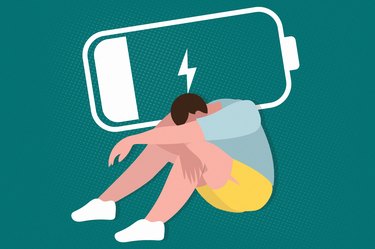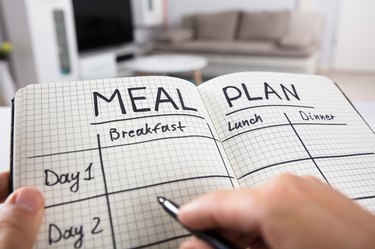
Say you recently started — or ramped up — your fitness routine, with a specific goal in mind. Perhaps you're aiming to finish a race, change your body composition or just improve your health.
But instead, as the days and weeks pass, you're feeling cranky, foggy and tired. If you menstruate, your periods might become irregular, or stop altogether. Your sex drive can also take a nosedive. And it might seem like the harder you work at the gym or on the running or cycling path, the less progress you make.
Video of the Day
Video of the Day
What's behind this frustrating situation? You may have created a mismatch between the amount of calories or energy you take in and how much you're expending.
Short of resources, your body begins "turning the volume down" on your hormone systems, says Marci Goolsby, MD, a sports medicine physician at the Hospital for Special Surgery and medical director of the Women's Sports Medicine Center.
If you don't address the issue, you can develop a syndrome called relative energy deficiency in sport (RED-S), says Rebecca McConville, MS, RD, a registered dietitian and author of the book Finding Your Sweet Spot: How to Avoid RED-S by Optimizing Your Energy Balance.
Over time, RED-S can lead to weak bones and fractures, fertility issues and cardiovascular complications, among other health problems, notes a May 2018 consensus paper from the International Olympic Committee published in the British Journal of Sports Medicine.
And anyone — regardless of sex or gender, age, body size or level of athletic ability — can develop it. But there is some good news.
"The great piece of it is, there is a solution," McConville says. "Most everything is reversible when you're adequately fed."
What Is RED-S, Exactly?
McConville describes RED-S as essentially running short on your body's energy bills. Consider all the fuel you expend not only through working out, but also when running errands, doing chores around the house or even just maintaining your basic bodily functions.
If you don't eat enough to power these activities — either calories overall, or a particular macronutrient, such as carbohydrates or protein — your body will pull from storage, or what she calls "savings accounts" in your body fat, muscles or liver.
"Then it's like the lights start getting dim in the house," she says. "Our digestion, our brain function, bone health, menstrual cycle and sex health will shut off as it means to conserve energy."
But what if you're trying to lose weight or fat? A slight caloric deficit that leads to gradual weight loss doesn't necessarily have negative health implications — but often, people cut back too much, or have unrealistic goals for their body shape or size.
Even a deficit of 250 to 400 calories per day can trigger subtle signs of dysfunction, McConville says.
In fact, people with RED-S may actually find themselves maintaining or gaining weight and losing muscle despite eating less, as their body flips into starvation mode and slows metabolism, she says.
What Are the Warning Signs of RED-S?
Symptoms that suggest an energy imbalance include:
- Trouble sleeping, or waking up hungry. This is especially common when you're short on carbs, which your body needs to formulate the sleep hormone melatonin, McConville says.
- Mood shifts, including feeling sad, irritable, or wanting to isolate yourself
- Trouble focusing
- Missing or irregular periods in people who menstruate
- Low libido, especially in men
- Frequent respiratory illnesses due to impaired immune function
- Disconnection from your body's hunger and fullness cues
- Gut problems
- Hair loss
- Declines in athletic performance (not being able to run as fast or as far, or to lift as much weight)
- Small injuries, or larger ones, including stress fractures
Bloodwork might also help tell the tale, McConville says. Many people with RED-S have low levels of iron and vitamin D, in part because their bodies can't properly absorb the nutrients.
Your levels of T3 and other thyroid hormones may drop, while thyroid stimulating hormone (TSH) rises. These differences can appear as early as a month or two, she notes.
Who Gets RED-S?
Ultimately, anyone who exercises more than they're fueling can get RED-S.
Elite athletes who train for hours each week can easily fall behind in fueling. It's common among endurance athletes such as runners or triathletes, as well as in sports where weight classes or aesthetics matter: think rowing, wrestling and figure skating.
But Dr. Goolsby also frequently spots RED-S in recreational runners or gymgoers, especially people who've recently made a change to their routine.
"For some people, it's a nutrition issue, and for some people it's an exercise issue," she says. In other words, you can create a deficiency by either exercising more or cutting back on what you're eating. "In most people, it's a combination of the two."
McConville also sees RED-S in people who frequent fitness studios offering high-intensity classes. "Say you're going to a boot camp class four or five days a week, and you're putting that demand on your body," she says. You might not think of yourself as an athlete, but you're asking as much of your body as a high-level competitor, she says.
And often, those tough workouts are paired with diet-centric messaging: instructions about limiting or cutting back on certain food groups, or on overall intake. "I've seen significant mismatches in energy availability, just due to that cultural piece of it," McConville says.
What’s the Link Between RED-S and Eating Disorders?
The relationship between RED-S and disordered eating or eating disorders is an important and complicated question. There can be some overlap, but they're not the same thing.
Sometimes, RED-S happens unintentionally, McConville says. You might add an extra few miles to your weekly running routine without realizing you need to eat more. Or you get busy during the day and accidentally skip meals or snacks.
Some people have no problem taking in more energy as soon as they realize there's a problem. "A lot of times, when somebody has the knowledge and education, they know better, they do better," McConville says.
However, many people who develop an energy imbalance fall in what Dr. Goolsby calls a "gray zone" of nutrition, in which their habits begin to become disordered. "They might be trying to kind of watch what they eat or eat 'clean,'" she says. "And then it can kind of get too far to the extreme," perhaps progressing to orthorexia, or an obsession with "healthy" eating.
If your response to symptoms of RED-S is to restrict or limit your diet further or exercise more, that's a red flag that there might be disordered eating involved. Also take note if anxiety and obsessiveness arise when you think about changing your habits.
What if You Think You Have RED-S?
If these symptoms are seeming familiar, talk to a health care provider trained in sports medicine. Ideally, you'd also work with a registered dietitian who's certified in sports dietetics and has experience in treating RED-S, McConville says. Look for the letters CSSD in their credentials and ask about their background.
With their help, you can identify gaps in your nutrition, whether that's skipping meals or not getting enough carbs, protein or fats, and work to fill them.
"Your body is like a race car; it needs enough fuel and the right kind of fuels to keep the machine going at top performance," Dr. Goolsby says.
You might also discuss changes to your fitness regimen: dialing down the intensity or increasing the amount of rest you take between workouts, for instance. If you struggle to make changes or have other signs of disordered eating or exercise addiction, a sport psychologist or eating disorder specialist can also play a key role in treatment, Dr. Goolsby says.
Complications such as missing periods and stress fractures may require more time and additional treatments. Be wary of physicians who suggest oral contraceptives to restore menstrual cycles — while pills are fine for birth control, they don't truly rebalance hormones or improve bone health, Dr. Goolsby says. The "withdrawal bleed" you have when you're not taking them isn't a true period, so they can actually mask the condition you're trying to address.
Instead, it's important to treat the underlying cause by eating more, exercising less or both. If your doctor does determine you need hormonal support, an estrogen patch is probably a better choice, according to clinical guidelines published in the Journal of Clinical Endocrinology & Metabolism in March 2017.
How Can You Prevent RED-S?
Consider doing your own "energy audit" from time to time, McConville recommends. You don't have to count calories, which can be a trigger for disordered eating or eating disorders. But she does recommend "calorie consciousness," or occasionally checking that what you're eating matches up with what you're expending.
One easy way is to think through the "FITT" principle of exercise: frequency, intensity, time and type. If you've made a change in one of these areas — working out more often, for longer or more intensely — you probably need to bump up your intake to compensate, she says. If you're unsure, a consultation with a sports dietitian can be helpful.
Dr. Goolsby also hopes for a continued paradigm shift to prevent underfueling and eating disorders, starting with young people and youth athletes. Parents, coaches, peers and health care providers should dispel myths that lighter is faster, that it's normal not to get a period, or that certain foods are "bad" or off-limits, instead "creating a little bit more acceptance of variety of body types and nutrition habits," she says.
These steps could establish a healthier relationship with food early, she says — one that can protect mental and physical health for years into the future.



